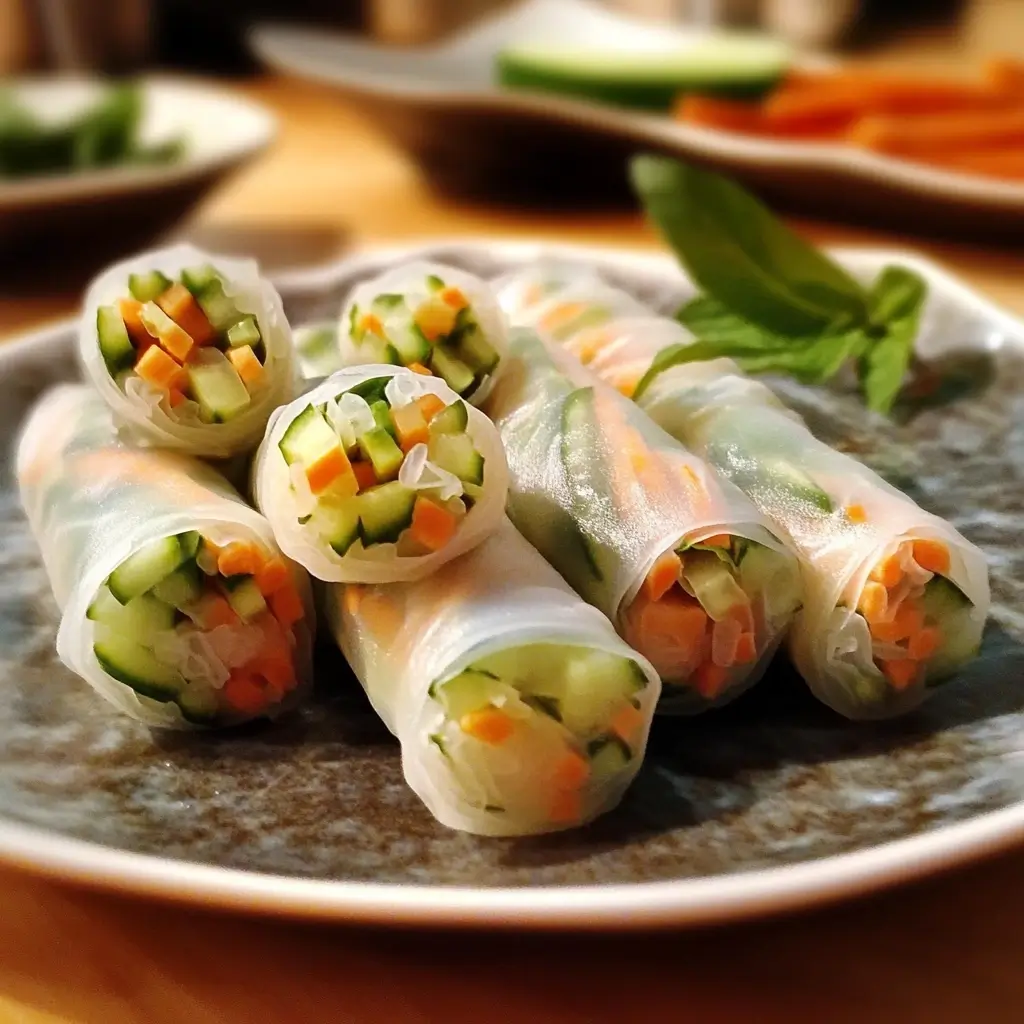I still remember the first time I decided to tackle fresh spring rolls. It was a sweltering summer afternoon, and the thought of turning on the oven was unbearable. I’d always loved ordering them at Vietnamese restaurants – those translucent parcels bursting with fresh, crisp vegetables and fragrant herbs, always served with that incredible peanut dipping sauce. I was convinced they were far too fiddly and complicated for a home cook like me. But, driven by the heat and a craving for something light and healthy, I gathered my courage and the ingredients. The star attractions were simple: vibrant carrots and cool, crisp cucumbers. My kids, usually skeptical of anything too “green,” were surprisingly intrigued by the colorful array of fillings. The first few rolls were admittedly a bit…rustic. Lopsided, a tear here and there. But by the fourth or fifth, I found my rhythm. The real magic happened when we all sat down to eat. Dipping those imperfectly perfect rolls into the creamy, savory-sweet peanut sauce was a revelation. The crunch of the vegetables, the slight chewiness of the rice paper, the burst of fresh mint and cilantro – it was pure, unadulterated deliciousness. My family devoured them, and my son, who usually turns his nose up at cucumbers, asked for seconds! Since that day, these Carrot Cucumber Spring Rolls have become a staple in our home, especially during warmer months. They’re not just food; they’re an experience – a fun, interactive way to eat healthily and enjoy a burst of freshness that brightens any meal. They’ve proven to be a surprising crowd-pleaser for potlucks and a guilt-free snack I can turn to anytime.
Ingredients
Here’s what you’ll need to create these delightful Carrot Cucumber Spring Rolls and the accompanying peanut dipping sauce:
For the Spring Rolls:
- 12-15 sheets of round rice paper (approx. 8-9 inches diameter): These are the delicate wrappers that, when hydrated, become pliable and translucent.
- 2 medium carrots (about 1.5 cups julienned): Peeled and julienned or finely shredded, providing sweetness and a vibrant orange crunch.
- 1 large cucumber (about 1.5 cups julienned): Preferably English or Persian, julienned with seeds removed if watery, for a cool, crisp element.
- 100g (3.5 oz) rice vermicelli noodles: Thin rice noodles that add a soft, satisfying texture.
- 1 cup fresh mint leaves: For a burst of cool, aromatic flavor.
- 1 cup fresh cilantro leaves: Adds a distinctive, bright, and slightly citrusy note.
- Optional: 1 cup shredded lettuce (e.g., butter lettuce or romaine hearts): Adds extra bulk and a tender crunch.
- Optional Protein (about 1 cup cooked and sliced/shredded):
- Cooked shrimp, peeled and deveined, sliced in half lengthwise: A classic and delicious addition.
- Firm tofu, pressed and pan-fried or baked, sliced into thin strips: A great vegetarian/vegan protein option.
- Shredded cooked chicken: For a heartier roll.
For the Peanut Dipping Sauce:
- 1/2 cup creamy peanut butter: The rich, nutty base of the sauce.
- 1/4 cup warm water: To thin the sauce to the desired consistency.
- 2 tablespoons soy sauce (or tamari for gluten-free): Adds savory depth and umami.
- 1 tablespoon rice vinegar: Provides a tangy counterpoint to the richness.
- 1 tablespoon honey or maple syrup (for vegan): For a touch of sweetness.
- 1 teaspoon freshly grated ginger: Adds a warm, zesty kick.
- 1 clove garlic, minced: For aromatic pungency.
- 1/2 – 1 teaspoon sriracha or chili garlic sauce (optional): For a hint of spice.
- 1 teaspoon lime juice (optional): Brightens up the flavors.
Instructions
Follow these steps carefully to assemble your delicious Carrot Cucumber Spring Rolls:
1. Prepare the Fillings:
* Cook Rice Vermicelli: Bring a small pot of water to a boil. Add the rice vermicelli noodles and cook according to package directions (usually 3-5 minutes), until just tender. Drain immediately and rinse thoroughly with cold water to stop the cooking process and remove excess starch. Set aside.
* Julienne Vegetables: Peel the carrots. Using a sharp knife, mandoline slicer, or julienne peeler, cut the carrots and cucumber into long, thin matchsticks (about 2-3 inches long). If using a regular cucumber with large seeds, you might want to scoop them out before julienning to prevent the rolls from becoming watery.
* Prepare Herbs: Wash and gently pat dry the mint and cilantro leaves. Pluck the leaves from any tough stems. If using lettuce, wash, dry, and shred or tear it into manageable pieces.
* Prepare Protein (if using): Ensure your chosen protein (shrimp, tofu, or chicken) is cooked and sliced or shredded into pieces suitable for rolling.
2. Make the Peanut Dipping Sauce:
* In a small bowl, whisk together the creamy peanut butter, warm water, soy sauce (or tamari), rice vinegar, honey (or maple syrup), grated ginger, minced garlic, and sriracha/chili garlic sauce (if using).
* Continue whisking until the sauce is smooth and well combined. If the sauce is too thick, add a little more warm water, one teaspoon at a time, until it reaches your desired consistency. It should be pourable but still thick enough to cling to the rolls.
* Stir in the optional lime juice for extra brightness. Taste and adjust seasonings if necessary (more sweetness, saltiness, or spice). Set aside.
3. Set Up Your Rolling Station:
* Fill a large, shallow dish (a pie plate or a large dinner plate with a lip works well) with warm water. This will be used to hydrate the rice paper.
* Arrange all your prepared fillings (vermicelli noodles, julienned carrots, julienned cucumber, mint, cilantro, lettuce, and protein if using) on a large platter or cutting board for easy access.
* Have a clean, damp kitchen towel or a smooth, clean work surface (like a large plastic cutting board) ready for rolling. Some people prefer to roll directly on a slightly damp plate.
4. Assemble the Spring Rolls:
* Hydrate Rice Paper: Take one sheet of rice paper and fully submerge it in the warm water for about 15-30 seconds, or until it becomes soft and pliable. It should be flexible but not so soft that it tears easily. Don’t oversoak.
* Lay Out Wrapper: Carefully remove the hydrated rice paper from the water, allowing excess water to drip off. Lay it flat on your damp towel or work surface.
* Add Fillings: On the third of the rice paper closest to you, arrange a small amount of the fillings in a neat log shape, leaving about an inch of border on each side. A good order might be: a few pieces of lettuce (if using), a small bundle of rice vermicelli, then a row of carrot and cucumber sticks, a few mint and cilantro leaves, and your protein (if using). Be careful not to overfill, as this will make rolling difficult and can cause the paper to tear.
* Fold the Sides: Take the left and right sides of the rice paper and fold them inwards over the edges of the filling. This creates a neat package and helps secure the filling.
* Roll it Up: Starting from the edge closest to you (where the filling is), tightly roll the rice paper away from you, like a burrito. Try to keep the roll snug to prevent it from falling apart, but not so tight that you tear the delicate rice paper. The rice paper will stick to itself to seal the roll.
* Repeat: Place the finished spring roll on a separate plate or platter, making sure it doesn’t touch other finished rolls initially, as they can stick together when freshly made. Repeat the process with the remaining rice paper sheets and fillings until all ingredients are used.
5. Serving:
* Serve the fresh Carrot Cucumber Spring Rolls immediately with the prepared peanut dipping sauce on the side.
* If not serving right away, cover the rolls with a damp paper towel and plastic wrap to prevent them from drying out. They are best enjoyed within a few hours of making.
Nutrition Facts
- Servings: This recipe typically yields 12-15 spring rolls, serving approximately 4-6 people as an appetizer or 2-3 people as a light meal.
- Calories per serving (approx. 3 rolls + 2 tbsp sauce): Around 250-350 calories, depending on exact ingredients and if protein is added.
Key Nutrition Highlights (per serving, approximate):
- Rich in Vitamins A & K: Carrots are packed with Beta-Carotene (Vitamin A), crucial for vision and immune health, while leafy greens and cucumbers contribute Vitamin K, important for blood clotting and bone health.
- Good Source of Fiber: The abundance of fresh vegetables and rice noodles provides dietary fiber, aiding digestion and promoting satiety.
- Low in Saturated Fat: Primarily made with fresh vegetables and lean protein options (if used), these rolls are naturally low in unhealthy saturated fats, especially when compared to fried alternatives.
- Provides Complex Carbohydrates: Rice vermicelli noodles offer complex carbohydrates for sustained energy, making these rolls a satisfying yet light option.
- Source of Plant-Based Protein (with tofu/peanut sauce): If using tofu and considering the peanut butter in the sauce, this dish offers a decent amount of plant-based protein, essential for muscle repair and growth.
Disclaimer: Nutritional information is an estimate and can vary based on specific ingredients, brands, and portion sizes used.
Preparation Time
- Chopping & Prep Time: 25-35 minutes (This includes julienning vegetables, cooking noodles, and preparing herbs and protein if used).
- Assembly Time: 20-30 minutes (Depending on your speed and experience with rolling rice paper).
- Total Time: Approximately 45-65 minutes.
This recipe involves more upfront preparation than actual cooking, making it a wonderfully fresh option that doesn’t require much heat. The process becomes quicker with practice.
How to Serve
Carrot Cucumber Spring Rolls are versatile and can be presented in various appealing ways:
- As an Appetizer:
- Arrange the spring rolls neatly on a large platter.
- Serve the peanut dipping sauce in a small bowl placed in the center or alongside the platter.
- Garnish the platter with extra fresh mint leaves, cilantro sprigs, or a sprinkle of sesame seeds for visual appeal.
- As a Light Lunch or Dinner:
- Serve 3-4 rolls per person.
- Accompany with a side salad, such as a simple Asian-inspired slaw or a light miso soup, to make it a more complete meal.
- Offer multiple dipping sauces for variety (e.g., a sweet chili sauce or a nuoc cham in addition to the peanut sauce).
- For Parties and Potlucks:
- If making a large batch, arrange them on a tray, ensuring they don’t touch too much or separate layers with plastic wrap or lettuce leaves to prevent sticking.
- Provide individual small dipping cups for guests if preferred, for hygiene and ease.
- Consider cutting the rolls in half diagonally before arranging them to showcase the colorful fillings and make them easier to handle.
- Interactive Serving:
- Set up a “spring roll bar” where guests can assemble their own rolls. Lay out all the prepared fillings, hydrated rice paper (kept moist under a damp towel), and dipping sauces. This is a fun and engaging way to cater to different preferences.
- Presentation Tips:
- To prevent sticking if making ahead, lightly brush the rolls with water or place them on a bed of lettuce leaves.
- A sprinkle of crushed peanuts or toasted sesame seeds on top of the peanut sauce can add extra texture and visual interest.
- Use colorful plates or serving dishes to complement the vibrant colors of the spring rolls.
Additional Tips
To ensure your Carrot Cucumber Spring Roll making experience is smooth and successful, here are eight valuable tips:
- Mastering Rice Paper Hydration: The key to good spring rolls is perfectly hydrated rice paper. Use warm water, not hot, as hot water can make the paper too sticky and fragile too quickly. Submerge each sheet for only 15-30 seconds, just until it’s pliable. It will continue to soften slightly as you add fillings. If your paper tears easily, you might be over-soaking it or using water that’s too hot.
- Don’t Overstuff the Rolls: It’s tempting to load up your rolls with lots of delicious fillings, but overstuffing is the primary cause of tearing. Start with a modest amount of filling; you can always add more to subsequent rolls once you get a feel for it. A well-proportioned roll is easier to handle and eat.
- Prep All Ingredients First (Mise en Place): Before you hydrate your first rice paper sheet, have all your vegetables julienned, noodles cooked and cooled, herbs washed, and protein (if using) cooked and sliced. An organized workstation makes the assembly process much smoother and more enjoyable.
- Work on a Damp Surface: Rolling on a slightly damp, clean kitchen towel or a dedicated plastic rolling mat can prevent the delicate rice paper from sticking to your work surface. Some people also use a large plate lightly wetted. Experiment to see what works best for you.
- Ingredient Variations for Texture and Flavor:
- Vegetables: Feel free to add other thinly sliced or julienned vegetables like bell peppers (red, yellow, or orange for color), bean sprouts for extra crunch, or thinly sliced radishes for a peppery bite.
- Herbs: Thai basil is another excellent herb option, offering a slightly anise-like flavor.
- Crunch: Consider adding a sprinkle of toasted sesame seeds or crushed peanuts inside the rolls for an unexpected textural element.
- Keep Finished Rolls from Sticking: Freshly made spring rolls can be quite sticky and will adhere to each other if placed too close together. To prevent this, either place them on a platter with a little space between each roll, or if you need to layer them, place a piece of plastic wrap or a large lettuce leaf between layers. A light brushing of water can also help temporarily.
- Customize Your Dipping Sauce: The peanut sauce is classic, but don’t be afraid to adjust it to your taste. Want it spicier? Add more sriracha or a pinch of red pepper flakes. Sweeter? A bit more honey/maple. Thinner? More water. You can also experiment with other dipping sauces like a traditional Vietnamese Nuoc Cham (fish sauce-based), a sweet chili sauce, or a hoisin-based dip.
- Making Ahead (Partially): While spring rolls are best enjoyed fresh, you can do some prep work in advance. Vegetables can be julienned and stored in an airtight container in the fridge for a day. The peanut sauce can be made up to 2-3 days ahead and stored in the refrigerator (it may thicken, so you might need to whisk in a little warm water before serving). Cooked noodles can also be prepared a few hours ahead, rinsed, and kept lightly moist. Assemble the rolls as close to serving time as possible for the best texture.
FAQ Section
Here are answers to some frequently asked questions about making Carrot Cucumber Spring Rolls:
1. Q: Can I make these spring rolls ahead of time?
A: Fresh spring rolls are best enjoyed within a few hours of making them, as the rice paper can dry out or become tough over time. If you need to make them a little ahead (e.g., 2-4 hours), cover them tightly with a damp paper towel and then plastic wrap, and store them in the refrigerator. Avoid stacking them directly unless separated by plastic wrap or lettuce. The fillings (vegetables, cooked noodles, sauce) can be prepared a day in advance and stored separately.
2. Q: Are Carrot Cucumber Spring Rolls vegan and/or gluten-free?
A: Yes, they can easily be both!
* Vegan: Ensure you use plant-based protein like tofu (or no protein), and use maple syrup instead of honey in the peanut sauce. The rice paper, noodles, and vegetables are naturally vegan.
* Gluten-Free: Rice paper wrappers and rice vermicelli noodles are naturally gluten-free. For the peanut sauce, use tamari instead of regular soy sauce, as soy sauce often contains wheat. Always double-check ingredient labels to be sure.
3. Q: My rice paper keeps tearing when I roll it. What am I doing wrong?
A: This is a common issue! It could be due to a few reasons:
* Over-soaking: Soaking the rice paper for too long makes it overly delicate. Aim for just 15-30 seconds in warm water until it’s pliable but not mushy.
* Water too hot: Hot water can make the paper too sticky and fragile. Use warm water.
* Overfilling: Too much filling will strain the paper. Start with less.
* Rough handling: Be gentle when folding and rolling.
* Dry work surface: A slightly damp surface can help prevent sticking and tearing.
4. Q: How should I store leftover spring rolls?
A: Store leftover spring rolls in an airtight container in the refrigerator. To prevent them from sticking together and drying out, you can wrap each roll individually in plastic wrap or place them in a single layer separated by damp paper towels or lettuce leaves. They are best consumed within 24 hours, though the texture might not be as good as when fresh. The peanut sauce should be stored separately in an airtight container in the fridge and may need a little warm water to thin out before re-serving.
5. Q: Can I use different types of noodles?
A: Rice vermicelli noodles are traditional and work best due to their thinness and delicate texture. However, you could experiment with other thin noodles. Soba noodles (buckwheat) could offer a different flavor profile, but they are thicker and might make rolling trickier. Avoid thick pasta-like noodles. If you use other noodles, ensure they are cooked, cooled, and not overly starchy.
6. Q: What are the best herbs to use in fresh spring rolls?
A: Mint and cilantro are classic choices and provide a fantastic fresh, aromatic flavor. Thai basil is another excellent option, adding a slightly sweet, anise-like note. Some people also enjoy using perilla leaves (shiso) for their unique flavor. The key is to use fresh, tender herbs.
7. Q: Can I bake or fry these spring rolls?
A: These particular spring rolls, made with fresh rice paper wrappers, are designed to be eaten fresh and un-cooked (often called summer rolls or salad rolls). They are not suitable for frying or baking as the rice paper wrapper used for fresh rolls will not crisp up nicely like the wrappers designed for fried spring rolls (which are typically wheat-based). If you want fried spring rolls, you’ll need to use specific spring roll pastry sheets (often found in the freezer section) and a different filling composition.
8. Q: My peanut dipping sauce is too thick/thin. How can I fix it?
A: This is easily adjustable!
* If too thick: Whisk in a little more warm water, one teaspoon at a time, until it reaches your desired consistency. You can also use a bit more lime juice or rice vinegar if you don’t want to dilute the flavor too much with just water.
* If too thin: You can try whisking in a little more peanut butter. Alternatively, if you don’t want to alter the flavor balance significantly, you can gently heat the sauce in a small saucepan over low heat for a few minutes, stirring constantly, which can help it thicken slightly as some moisture evaporates (be careful not to scorch it). Chilling it will also make it thicken.






